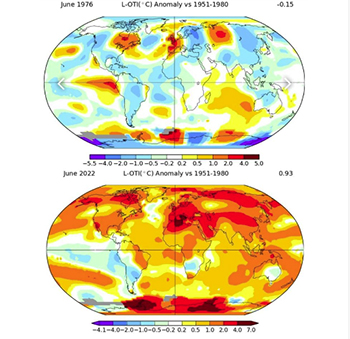Climate adaptation

|
| https://data.giss.nasa.gov//gistemp/maps/ |
Contents |
[edit] Introduction
Climate adaptation is a term often used in tandem with climate mitigation to describe the process of adjustment to current and future climates.
In terms of building design, the term resilience is often used to describe how well a building might withstand these changes. This can mean adjusting allowances for average and peak external temperatures, particularly in hotter months, but also considering higher wind speeds and driving rain and should be considered in tandem with potential knock-on effects such as increased cooling loads.
Some example studies from the UK government funded competition Design for Future Climate (D4FC) are useful as reference points, as well as BREEAM Adaptation to climate change and BRE Design for Future Climate - Developing an Adaptation Strategy.
[edit] UK climate projections
Globally the climate is changing. In the UK these changes have been recorded by the Met Office Hadley Centre since the 1990’s. This work has led to projections being issued, such as the UK climate projections in 2009 (UKCP09), which can be considered as a key resource informing regulations and policy-making in the.
Although projections are limited in their robustness they represent one of the best sources of knowledge we have. The Special Report on Emission Scenarios (SRES) that was used in these projections did not consider the potential impact of mitigation measures, and so to incorporate this a set of pathways projections were developed. Ref https://www.metoffice.gov.uk/research/approach/collaboration/ukcp/index
[edit] Representative concentration pathways
Representative Concentration Pathways (RCPs) are used as a method for projecting within a certain set of scenarios used for modelling. The emission scenarios are based on the difference between incoming and outgoing radiation (caused by emissions), these have been set at 2.6, 4.5, 6.0 and 8.5 watts per square metre (Wm-2). The names of the Representative Concentration Pathways reflect these with RCP2.6, RCP4.5, RCP6.0. and RCP8.5. Each pathway results in a different change in global mean temperature; 1.6 (0.9-2.3), 2.4 (1.7-3.2), 2.8 (2.0-3.7), 4.4 (3.2-5.4) degrees C respectively for the years between 2081-2100.
[edit] Related articles on Designing Buildings
- Adaptability.
- Approved Document O.
- Better prediction of overheating in new homes.
- Comfort in low energy buildings.
- Resilience.
- BREEAM Adaptation to climate change.
- BREEAM Designing for durability and resilience.
- Building back better with BREEAM.
- Building Back Better: Resilience
- Building flood resilience.
- Business resilience.
- Climate resilient places.
- Designing resilient cities: a guide to good practice (EP 103).
- Design summer year (DSY)
- Engineering in the 21st century.
- Engineering resilience to human threats.
- Environmental plan for building design and construction.
- Flood resilience.
- Future proofing construction.
- Hurricane design considerations.
- Managing and responding to disaster.
- Overheating in buildings
- Pressing pause to avoid errors.
- Property flood resilience.
- Re-evaluating the design life of buildings.
- Resilient infrastructure diversity and equity scorecard.
- Risk assessment.
- Shelter.
- Sustainability in building design and construction.
- Test reference year (TRY)
- Two steps towards a more resilient world.
Featured articles and news
Professional practical experience for Architects in training
The long process to transform the nature of education and professional practical experience in the Architecture profession following recent reports.
A people-first approach to retrofit
Moving away from the destructive paradigm of fabric-first.
International Electrician Day, 10 June 2025
Celebrating the role of electrical engineers from André-Marie Amperè, today and for the future.
New guide for clients launched at Houses of Parliament
'There has never been a more important time for clients to step up and ...ask the right questions'
The impact of recycled slate tiles
Innovation across the decades.
EPC changes for existing buildings
Changes and their context as the new RdSAP methodology comes into use from 15 June.
Skills England publishes Sector skills needs assessments
Priority areas relating to the built environment highlighted and described in brief.
BSRIA HVAC Market Watch - May 2025 Edition
Heat Pump Market Outlook: Policy, Performance & Refrigerant Trends for 2025–2028.
Committing to EDI in construction with CIOB
Built Environment professional bodies deepen commitment to EDI with two new signatories: CIAT and CICES.
Government Grenfell progress report at a glance
Line by line recomendation overview, with links to more details.
An engaging and lively review of his professional life.
Sustainable heating for listed buildings
A problem that needs to be approached intelligently.
50th Golden anniversary ECA Edmundson apprentice award
Deadline for entries has been extended to Friday 27 June, so don't miss out!
CIAT at the London Festival of Architecture
Designing for Everyone: Breaking Barriers in Inclusive Architecture.
Mixed reactions to apprenticeship and skills reform 2025
A 'welcome shift' for some and a 'backwards step' for others.





















